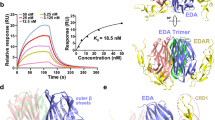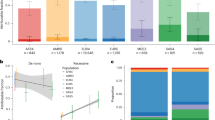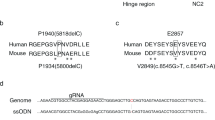Abstract
Hypohidrotic ectodermal dysplasia (HED) can be caused by mutations in the X-linked ectodysplasin A (ED1) gene or the autosomal ectodysplasin A-receptor (EDAR) and EDAR-associated death domain (EDARADD) genes. X-linked and autosomal forms are sometimes clinically indistinguishable. For genetic counseling in families, it is therefore important to know the gene involved. In 24 of 42 unrelated patients with features of HED, we found a mutation in ED1. ED1-negative patients were screened for mutations in EDAR and EDARADD. We found mutations in EDAR in 5 of these 18 patients. One mutation, p.Glu354X, is novel. In EDARADD, a novel variant p.Ser93Phe, probably a neutral polymorphism, was also found. Clinically, there was a difference between autosomal dominant and autosomal recessive HED patients. The phenotype in patients with mutations in both EDAR alleles was comparable to males with X-linked HED. Patients with autosomal dominant HED had features comparable to those of female carriers of X-linked HED. The teeth of these patients were quite severely affected. Hypohidrosis and sparse hair were also evident, but less severe. This study confirms Chassaing et al's earlier finding that mutations in EDAR account for approximately 25% of non-ED1-related HED. Mutations leading to a premature stop codon have a recessive effect except when the stop codon is in the last exon. Heterozygous missense mutations in the functional domains of the gene may have a dominant-negative effect with much variation in expression. Patients with homozygous or compound heterozygous mutations in the EDAR gene have a more severe phenotype than those with a heterozygous missense, nonsense or frame-shift mutation.
Similar content being viewed by others
Log in or create a free account to read this content
Gain free access to this article, as well as selected content from this journal and more on nature.com
or
References
Stevenson AC, Kerr CB : On the distribution of frequencies of mutation to genes determining harmful traits in man. Mutat Res 1967; 4: 339–352.
Monreal AW, Ferguson BM, Headon DJ, Street SL, Overbeek PA, Zonana J : Mutations in the human homologue of mouse dl cause autosomal recessive and dominant hypohidrotic ectodermal dysplasia. Nat Genet 1999; 22: 366–369.
Chassaing N, Bourthoumieu S, Cossee M, Calvas P, Vincent MC : Mutations in EDAR account for one-quarter of non-ED1-related hypohidrotic ectodermal dysplasia. Hum Mutat 2006; 27: 255–259.
Naeem M, Muhammad D, Ahmad W : Novel mutations in the EDAR gene in two Pakistani consanguineous families with autosomal recessive hypohidrotic ectodermal dysplasia. Br J Dermatol 2005; 53: 46–50.
Shimomura Y, Sato N, Miyashita A, Hashimoto T, Ito M, Kuwano R : A rare case of hypohidrotic ectodermal dysplasia caused by compound heterozygous mutations in the EDAR gene. J Invest Dermatol 2004; 123: 649–655.
Lind KL, Stecksén-Blicks C, Lejon K, Schmitt-Egenolf M : EDAR mutation in autosomal dominant hypohidrotic ectodermal dysplasia in two Swedish families. BMC Med Genet 2006; 7: 80.
Tariq M, Wasif N, Ahmad W : A novel deletion mutation in the EDAR gene in a Pakistani family with autosomal recessive hypohidrotic ectodermal dysplasia. Br J Dermatol 2007; 157: 207–209.
Headon DJ, Emmal SA, Ferguson BM et al: Gene defect in ectodermal dysplasia implicates a death domain adapter in development. Nature 2001; 414: 913–916.
Vincent MC, Biancalana V, Ginisty D, Mandel JL, Calvas P : Mutational spectrum of the ED1 gene in X-linked hypohidrotic ectodermal dysplasia. Eur J Hum Genet 2001; 9: 355–363.
Maquat LE : Nonsense-mediated mRNA decay in mammals. J Cell Sci 2005; 118: 1773–1776.
Acknowledgements
We thank the patients and their families for their kind cooperation. Clinicians are acknowledged for sending DNA samples from their HED patients to our laboratory. We thank Mrs Jackie Senior for critically reviewing the paper.
Author information
Authors and Affiliations
Corresponding author
Rights and permissions
About this article
Cite this article
van der Hout, A., Oudesluijs, G., Venema, A. et al. Mutation screening of the Ectodysplasin-A receptor gene EDAR in hypohidrotic ectodermal dysplasia. Eur J Hum Genet 16, 673–679 (2008). https://doi.org/10.1038/sj.ejhg.5202012
Received:
Revised:
Accepted:
Published:
Issue date:
DOI: https://doi.org/10.1038/sj.ejhg.5202012
Keywords
This article is cited by
-
EDA, EDAR, EDARADD and WNT10A allelic variants in patients with ectodermal derivative impairment in the Spanish population
Orphanet Journal of Rare Diseases (2019)
-
Mutational spectrum in 101 patients with hypohidrotic ectodermal dysplasia and breakpoint mapping in independent cases of rare genomic rearrangements
Journal of Human Genetics (2016)
-
Molecular basis of hypohidrotic ectodermal dysplasia: an update
Journal of Applied Genetics (2016)
-
Orofacial Features of Hypohidrotic Ectodermal Dysplasia
Head and Neck Pathology (2012)
-
A compound heterozygous mutation in the EDAR gene in a Spanish family with autosomal recessive hypohidrotic ectodermal dysplasia
Archives of Dermatological Research (2010)



